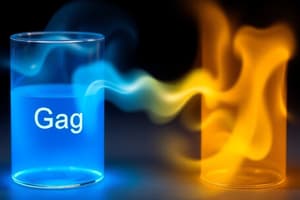Podcast
Questions and Answers
What is the relationship between specific volume (v) and pressure (P) in an isentropic process as modeled by the PG model?
What is the relationship between specific volume (v) and pressure (P) in an isentropic process as modeled by the PG model?
The isentropic process relates specific volume and pressure through the equation $T_1 v_1^{k-1} = T_2 v_2^{k-1}$. This shows that specific volume changes with temperature and pressure during an isentropic process.
How is the work done (W) calculated in a general sense during a process?
How is the work done (W) calculated in a general sense during a process?
The work done is calculated using $W = ∫ F ⋅ ds$, where F is the force and ds is the displacement. In terms of pressure-volume work, it can also be expressed as $W = ∫ Pdv$.
What is the expression for total work done in a fluid moving through a boundary according to the work done equations provided?
What is the expression for total work done in a fluid moving through a boundary according to the work done equations provided?
Total work done is expressed as $W = m ∫ Pdv$, where m is the mass flow rate. This incorporates mass into the work done over volume change.
Define the coefficient of performance (COP) in relation to heat transfer.
Define the coefficient of performance (COP) in relation to heat transfer.
In terms of energy properties, how is enthalpy (H) related to internal energy (U) and pressure-volume work?
In terms of energy properties, how is enthalpy (H) related to internal energy (U) and pressure-volume work?
Explain the significance of the equation $du = cv dT$ in thermodynamic processes.
Explain the significance of the equation $du = cv dT$ in thermodynamic processes.
What do the terms $h_x$, $u_x$, and $v_x$ signify in terms of mixtures of liquid and vapor?
What do the terms $h_x$, $u_x$, and $v_x$ signify in terms of mixtures of liquid and vapor?
What is the relationship between specific heats $c_p$ and $c_v$, and the gas constant (R) according to the information provided?
What is the relationship between specific heats $c_p$ and $c_v$, and the gas constant (R) according to the information provided?
What is the Ideal Gas Equation and what do the variables represent?
What is the Ideal Gas Equation and what do the variables represent?
What is the specific gas constant for air and how is it derived?
What is the specific gas constant for air and how is it derived?
How is mass balance expressed in an open system?
How is mass balance expressed in an open system?
What does the energy balance equation represent in an open system?
What does the energy balance equation represent in an open system?
What components are included in the entropy balance for an open system?
What components are included in the entropy balance for an open system?
Explain how to calculate the change in entropy for ideal gases.
Explain how to calculate the change in entropy for ideal gases.
What is the significance of the term S_gen in the entropy balance equation?
What is the significance of the term S_gen in the entropy balance equation?
In terms of energy balance, what does the expression ΔEsys include in closed systems?
In terms of energy balance, what does the expression ΔEsys include in closed systems?
Flashcards
Isentropic Process
Isentropic Process
A thermodynamic process where entropy remains constant. It is characterized by reversible adiabatic changes.
Polytropic (PG) Model
Polytropic (PG) Model
A model used for describing the behavior of ideal gases during isentropic processes. It relates pressure, volume, and temperature using the polytropic index 'k'.
Boundary Work
Boundary Work
The work done on or by a system due to boundary movement, specifically the expansion or compression of the system's volume.
Shaft Work
Shaft Work
Signup and view all the flashcards
Power
Power
Signup and view all the flashcards
Thermal Efficiency
Thermal Efficiency
Signup and view all the flashcards
Coefficient of Performance (COP)
Coefficient of Performance (COP)
Signup and view all the flashcards
Enthalpy (H)
Enthalpy (H)
Signup and view all the flashcards
Ideal Gas Equation
Ideal Gas Equation
Signup and view all the flashcards
Specific Gas Constant
Specific Gas Constant
Signup and view all the flashcards
Mass Balance
Mass Balance
Signup and view all the flashcards
Energy Balance
Energy Balance
Signup and view all the flashcards
Entropy Balance
Entropy Balance
Signup and view all the flashcards
Entropy Changes of Ideal Gases
Entropy Changes of Ideal Gases
Signup and view all the flashcards
Specific Heat Capacity
Specific Heat Capacity
Signup and view all the flashcards
Ideal Gas Constant
Ideal Gas Constant
Signup and view all the flashcards
Study Notes
Ideal Gas Equation
- Pv = RT or PV = mRT, where R = Ru/MW
- Rair = 0.287 kJ/kg·K = 0.287 kPa·m³/kg·K (use table A-1 for other gases)
Mass Balance
- dm/dt = Σmin - Σmout = ρAV
Energy Balance
- Open: dE/dt = E_in - E_out
- E_in = Σ m_in(h_in + V² / 2 + gz_in )
- E_out = Σ m_out(h_out + V² / 2 + gz_out)
- Open (Expanded): d(E_sys)/dt = (Qin + Win) − (Qout + Wout) + Σ m_in(h_in + V² / 2 + gz_in) − Σ m_out((h_out + V² / 2 + gz_out))
- Closed: ΔE_sys = E_in - E_out
Entropy Balance
- Open: ds/dt = ΣS_in - ΣS_out + S_gen /dt
- Where S_in and S_out can be mass, heat transfer, or both
- Closed: ΔS_sys = ∑ S_in − ∑ S_out + S_gen
Entropy Changes of Ideal Gases
- Δs = C_v ln(T₂/T₁) + R ln(V₂/V₁) or Δs = C_p ln(T₂/T₁) − R ln(P₂/P₁)
- NOTE: This assumes constant specific heats.
Isentropic Process
- T₁v¹⁻ᵏ = T₂v₂¹⁻ᵏ
- Pvᵏ = P₂v₂ᵏ
Different Types of Work
- General: W = ∫ F ⋅ ds
- Boundary: W = ∫ Pdv (Specific) W = m∫ Pdv (Total)
- Electrical: W = V ⋅ I
- Shaft: Wshaft = 2πnτ
Reversible Steady Flow Work
- W = ∫ v dP (Specific) = m∫ v dP (Total)
Efficiency and COP
- η = W_net,out / W_in
- COP_R=Q_out / W_in
- COP_HP = Q_in / W_in
Properties
- h = u + Pv or H = U + PV
- du = C_v dT , dh = C_p dT, Cp = Cv + R
- For any property, Y = mY (upper case is total, lower case is specific)
- X = (mass_vapor / mass_total), V_x = V_f + X(V_g-V_f)
- U_x = U_f + X(U_g - U_f), h_x = h_f + X(h_g - h_f)
Studying That Suits You
Use AI to generate personalized quizzes and flashcards to suit your learning preferences.




